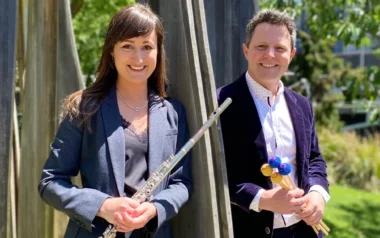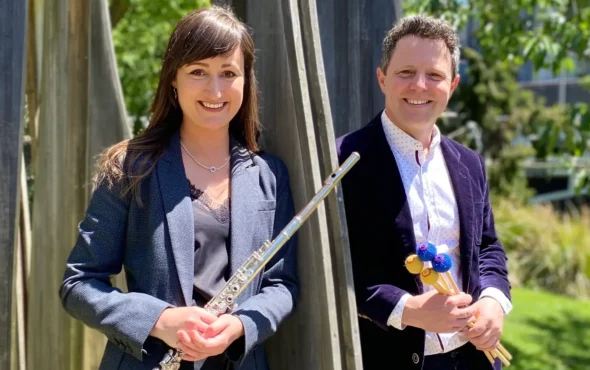 New Zealand Various: Darroch/DeHart Duo (Hannah Darroch [flutes], Justin DeHart [percussion]). Old Library, Whangarei, New Zealand, 25.8.2024. (PSe)
New Zealand Various: Darroch/DeHart Duo (Hannah Darroch [flutes], Justin DeHart [percussion]). Old Library, Whangarei, New Zealand, 25.8.2024. (PSe)

Lou Harrison – First Concerto for Flute and Percussion
Takemitsu – Toward the Sea
Celeste Oram – Notes on the Nocturne Tradition
Gareth Farr – Kembang Suling: Three Musical Snapshots of Asia
Helen Fisher – Te Tangi a te Matui
David Lang – lend/lease
Daniel Corral – Heptomino
Amy Williams – Cinescape 1
Andy Akiho – Karakurenai
For many years, it seems, percussion has been increasingly determined to get out of ‘the kitchen’. For instance, last year Whangarei Music Society was royally entertained by the percussion duo Double Shot (review here), who ably demonstrated the expressive potential of their instruments. And now here is more, from the Darroch/DeHart Duo – although, I hasten to add, by no means ‘more of the same’, because half of this duo plays flutes, and their aim is to make a musical marriage of these unlikely ‘bedfellows’.
New Zealander Hannah Darroch and Californian Justin DeHart both excel in a range of musical genres, teach (University of Canterbury, NZ), are highly qualified, widely travelled, and have garnered a wealth of experience. Reassuring this may be, but more important is that these two displayed obvious empathy and shared enthusiasm for communicating with their audience.
This was evident in the very layout of the performance space: rather than being lined up like a barricade, the large array of percussion instruments was spread forward into the audience area, enfolded, ‘in the round’, by a full semicircle of seating – thus literally interpreting Chamber Music NZ’s motto, ‘Music up Close’. However, this did not involve Justin constantly running from one instrument to another; it soon became clear that the instruments required for each piece were carefully grouped, so that between pieces he and Hannah merely moved at leisure from one station to another. In passing, I am probably not alone in my ignorance of the names of some of the instruments – so I apologise now for any made-up names couched in quotes.
I have come to expect that programmes featuring oddball instrumental combinations will largely consist of arrangements. Refreshingly, this one bucks the trend, besides which its opening item hints at just how many years percussion has been seeking its liberation and gives us some idea of how long flute and percussion have been partnered: Lou Harrison wrote his First Concerto for Flute and Percussion way back in 1939! The first movement involved a tom-tom, a wood block and a ‘Y-shaped shaker’ with tambourine jingles, whilst in the second the flute’s fluid, languorous lyricism was set against the soft, atmospheric sounds of gongs, tom-tom and (I think) a crotale. The third found the flurrying flute nigh-on gabbling against a hypnotic rhythm of güiro, tom-toms and a ‘tin coconut shell’.
Commissioned by Greenpeace for its ‘Save the Whales’ campaign (early 1980s), Takemitsu’s Toward the Sea exists in three versions; the one we heard being for alto flute and marimba. Takemitsu stretched the flute’s capabilities to imitate the sound of the shakuhachi. Hannah put this across so effectively that, especially in the second movement, it vividly brought to my mind the shakuhachi in his November Steps, a recording of which I acquired – quite accidentally – when I bought Ozawa’s LP of Turangalîla-Symphonie in 1968. The flute – when not imitating ‘the sound the wind makes when it blows through a decaying bamboo grove’ – and marimba blended beguilingly.
Celeste Oram’s Notes on the Nocturne Tradition for percussion emerged from her continuing fascination with Alison Glenny’s 2021 poetry pamphlet, The Bird Collector, and took form following an invitation to write a piece for Justin. Interweaving the performance with recorded speech, intended (I presume) to ‘prompt’ the marimba’s elaborations, may have been a good idea in theory – but folly in practice: I missed much of the music because I was trying, frantically but fruitlessly, to make out the words! Still, Justin’s command of the music’s intricacies was impressive in itself – and I did spot a verbal reference to ‘gamelan’ that gave me one instance of words and response.
Last before the interval was Gareth Farr’s Three Musical Snapshots of Asia for marimba and soprano/alto flutes, again involving gamelan (first movement) and shakuhachi (second movement). The former was cyclic, quick and agile, fascinatingly interweaving and rippling, the latter contrastingly otherworldly; the flute haunting, the marimba rolling mysteriously; gentle music, like swirling mist. The third snapshot evoked Southern India through a lively instrumental competition, whose notes flashed ever faster.
As part I ended with a Kiwi, so did part II begin, with Helen Fisher’s Te Tangi a te Matui (‘The Cry of the North’), which demanded considerable expertise: breathy sounds, microtones, much note-bending – and singing. Happily, Hannah’s soulful singing voice matched her flute for purity, and she was a whiz at blending the two, by bringing the flute to her lips while singing, a magical effect.
Next came David Lang’s lend/lease, written for a London Sinfonietta birthday – quite how the World War II ‘lend-lease’ programme came into it I am not at all sure. Nevertheless, the vaguely ‘Chinese-accented’ combination of piccolo and wood blocks, which have similar tessituras, had an attractive sound and a certain easy charm.
Daniel Corral’s Heptomino is one of those works whose ‘inspiration’ is contrived. A heptomino is any of a set of polygons, each comprising the outline of seven equal squares connected edgewise. This piece involves a flute using any seven consecutive quarter tones and a percussionist playing on any seven resonant (‘found’) objects. Would it make any material difference if, say, the flute played the seven tones of a diatonic key, or the percussionist happened to have found nine objects? Of more interest is that the percussion sounded somewhat like Harry Partch’s Spoils of War, and that some of the music hints at Partch’s style. Anyway, this virtuosic piece featured lots of well-varied intriguing sounds and was all the more enjoyable for being ‘on the wild side’.
Drawn from a suite written for an ingenious audio-visual project, Amy Williams’s Cinescape 1 was scored for alto flute, bass drum and crotales. It is fascinating music of timbre and texture, in parts possessing immense rhythmic drive, in parts amorphous. Hannah again showed her technical prowess, tossing out harmonics, ‘breath notes’, ‘bent notes’ and what-have-you like there’s no tomorrow; while Justin gleefully traversed an entire catalogue of bass drum effects, including finger and heel-of-hand drumming, brush-dragging, flicking, ‘rim shots’, even ‘trying to burst the drum-skin’ – all good, clean fun!
Finally came Andy Akiho’s Karakurenai (‘foreign crimson’), originally intended for ‘prepared steel drum’ (a concept to conjure with), but – according to Akiho – ‘can be performed on any combination of instruments’. His invitation was taken up by Hannah’s flute and Justin’s marimba. With the flute chanting against the marimba’s gamelan-style ostinato, the music gradually got livelier and adopted a modestly jazzy feel: a splendid finale.
Did the Hannah and Justin achieve their aim? I would say that they not only successfully wedded flutes and percussion, but also celebrated the union with a veritable feast of entertainment.
Paul Serotsky
